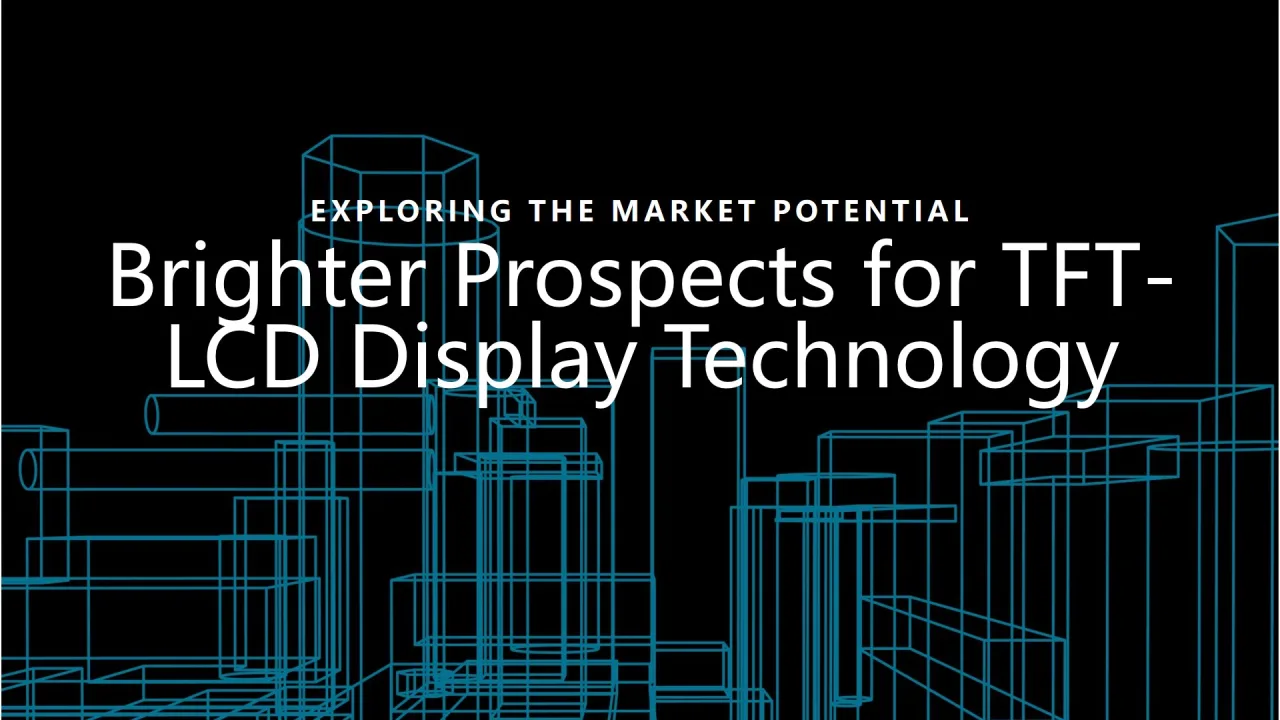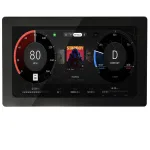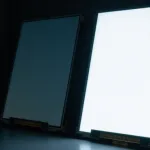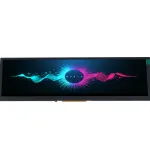Views: 0 views
Recently, a quick search on Google reveals numerous articles discussing the application prospects of TFT-LCD display technology. The general consensus is that TFT-LCD has become a thing of the past, with current TFT-LCD display technologies being dominated by Mini-LED and AMOLED, and potentially replaced by Micro-LED in the future.
From the perspective of my industry experience and the insights I’ve gathered from various articles and books I’ve studied, I’d like to share my thoughts.
There are many types of TFT-LCD display technology. Discussing TFT-LCD display technology in isolation, without any comparisons, might come across as “tooting one’s own horn” and could make it harder for readers to fully grasp the context.
Therefore, in today’s article, we’ll break things down into three key sections:
- Categories of mainstream flat-panel TFT-LCD display technology.
- Sizes, applications, and technical explanations of flat-panel display products.
- Key parameters of mainstream flat-panel TFT-LCD display technology.
Let’s dive in!
1.Mainstream Flat-Panel TFT-LCD Display Technology Categories
Display technologies can generally be divided into two main categories: cathode ray tube (CRT) display technology and flat-panel display technology.
CRT, or cathode ray tube, is a term that millennials’ readers might find particularly familiar. In contrast, flat-panel display technology encompasses a wider variety of types. Over the years, multiple display technologies have coexisted, creating a vibrant and competitive landscape where various approaches flourished.
Some of you may not be familiar with mainstream flat-panel display technologies, so let me briefly explain:
- TFT-LCD (Thin-Film Transistor Liquid Crystal Display): TFT-LCD can be classified based on the materials used in the TFT channel layer. Common materials used in LCD include: Amorphous Silicon (a-Si), Indium Gallium Zinc Oxide (IGZO), and Low-Temperature Polycrystalline Silicon (LTPS). There is also Low-Temperature Polycrystalline Silicon Oxide (LTPO), which combines the advantages of both IGZO and LTPS, but LTPO is primarily used in high-end AMOLED displays.
- OLED (Organic Light Emitting Diode): OLED displays can be classified based on their driving method into Active Matrix OLED (AMOLED) and Passive Matrix OLED (PMOLED). Due to the limitations of PMOLED, such as difficulties in scaling to large sizes, low resolution, short lifespan, and narrow application range, it is less commonly used. Most OLED displays in the market today are AMOLED. AMOLED can be further divided into four categories based on different technologies: QD-OLED (Samsung), WOLED (LGD), RGB-OLED (also known as FMM-OLED, the mainstream in the market), and Printed OLED (recently announced by TCL CSOT for mass production).
- LED (Light Emitting Diode): LED is a very mature TFT-LCD display technology. It can be classified into three types based on the size of the LED chip: LED, Mini-LED, and Micro-LED. Mini-LED chips typically range from 50 to 200 microns, while Micro-LED chips are generally smaller than 50 microns. Mini-LED technology can be further divided into Mini-LED backlight and Mini-LED direct display.
- Quantum Dot Display (QD): Strictly speaking, quantum dot technology cannot be considered a TFT-LCD display technology by itself, as quantum dots cannot independently create an image. However, quantum dot display devices, developed using this technology, can display images on their own. Typical applications of quantum dot technology include:
- EPD (Electrophoretic Display): Also known as E-paper Display, EPD offers advantages such as high reflectivity, ultra-low power consumption, wide viewing angles, and flexibility, making it well-received by consumers. However, EPD technology has limitations in terms of resolution, response time, color saturation, contrast, and cost, which somewhat limits its application. EPD can be classified into: Microcup technology, Microcapsule technology, Inverted ball technology, Cholesteric Liquid Crystal technology. The mainstream technology currently in use is microcapsule technology for black-and-white or two-color displays and microcup technology for multi-color displays.
2 TFT-LCD Display Technology Display Sizes, Applications, and Technology Overview
In this section, we will discuss the sizes, primary application areas, and potential TFT-LCD display technology used in flat-panel display products.
1、Micro-Displays
Micro-displays generally refer to display modules with sizes ranging from 0.5 to 1.3 inches. These display modules are typically used in VR, AR, MR, Helmet-mounted display, and sighting device.

Based on the characteristics of micro-display technology, the display technologies used include: TFT-LCD (Fast-LCD), Silicon-based OLED, Micro-LED, Silicon-based LCD (LCOS), Digital Light Processing (DLP), and Laser Beam Scanning (LBS).
In the VR/MR headset field, Fast-LCD technology is the mainstream, while Silicon-based OLED is the standard for high-end flagship products. In the AR headset and sighting scope fields, Silicon-based OLED is the mainstream, with Micro-LED being the long-term technology direction.
2、Small-Sized Displays
Small-sized displays typically refer to display modules with sizes ranging from 1.3 to 7.0 inches. These display modules are commonly used in VR, wearable devices, smartphones, and other fields. The TFT-LCD display technology used in this size range include: TFT-LCD, AMOLED, Mini-LED backlight + LCD, and Micro-LED.
Typical application diagram of small-sized display products

In VR products, Fast-LCD is the dominant technology. For mid-to-low-end wearable devices and smartphones, TFT-LCD is mainstream, while AMOLED is the standard for mid-to-high-end and flagship products.
3、Medium-Small-Sized Displays
Medium-small-sized displays typically refer to display modules with sizes ranging from 7.0 to 20 inches. These display modules are commonly used in tablets, automotive displays, laptops, and other fields. The TFT-LCD display technology used in this size range include: TFT-LCD, AMOLED, and Mini-LED backlight + LCD.

For mid-to-low-end tablets, automotive displays, and laptops, TFT-LCD is the mainstream technology. For mid-to-high-end or flagship products, AMOLED and Mini-LED backlight + LCD technologies are becoming the mainstream trend. Some products may incorporate quantum dot technology to enhance color saturation.
It is evident that companies like Samsung, BOE, and Visionox are establishing G8.6 AMOLED production lines, with the produced panels primarily used in tablets, automotive displays, laptops, and other IT fields, aiming to secure a foothold in the medium-small-sized AMOLED display market. Additionally, Tianma focuses on Mini-LED backlight + LCD for automotive displays, while TCL CSOT is focusing on this technology for laptop displays.
4、Medium-Sized Displays
Medium-sized displays typically refer to display modules with sizes ranging from 20 to 35 inches. These display modules are commonly used in desktop office monitors, gaming monitors, and automotive displays. The TFT-LCD display technology used in this size range include: TFT-LCD, AMOLED, and Mini-LED backlight + LCD.

For mid-to-low-end desktop office monitors, gaming monitors, and automotive displays, TFT-LCD is the mainstream technology. For mid-to-high-end or flagship products in the gaming and automotive display fields, AMOLED and Mini-LED backlight + LCD technologies are becoming the mainstream trend. Some products may incorporate quantum dot technology to enhance color saturation.
5、Large-Sized Displays
Large-sized displays typically refer to display modules with sizes ranging from 35 to 110 inches. These display modules are commonly used in televisions, conference displays, and other similar fields. The display technologies used in this size range include: TFT-LCD, AMOLED, and Mini-LED backlight + LCD.

For mid-to-low-end televisions and conference displays, TFT-LCD is the mainstream technology. High-end televisions typically adopt Mini-LED backlight + LCD solutions, with some products incorporating quantum dot technology to enhance color saturation.
Flagship televisions will undoubtedly use AMOLED technology. However, due to cost constraints, Mini-LED backlight + LCD solutions enhanced with quantum dot technology have greater market potential and stronger competitiveness.
6、Extra-Large Displays
Extra-large displays typically refer to display modules with sizes greater than 110 inches. These display modules are commonly used in conference all-in-one systems, outdoor large-screen advertisements, conference control centers, and other similar fields.

Why is the size of extra-large displays defined as above 110 inches? This is mainly because the largest production line for TFT-LCD panels is the G11 generation, and its most economical cutting size is 110 inches. If a TFT-LCD panel exceeds 110 inches, it requires a splicing solution, which significantly increases costs and reduces advantages.
As a result, LED display technology, especially Mini-LED direct-view technology, plays a significant role in the application of extra-large displays. After all, when viewed from a distance, the pixel density (PPI) requirements for the display panels are not as high.
We can observe that as the size of display products increases, the available display technologies become more limited, with TFT-LCD being the only technology applicable across all sizes. At the same time, by leveraging technologies like Mini-LED backlighting, quantum dot technology, or other innovations, the lifecycle of TFT-LCD can be further extended and enhanced.
3 Key Parameters of Mainstream Flat Panel TFT-LCD display technology
The first two sections mainly cover the classification of mainstream flat-panel display technologies, the application of display technologies across various product sizes, and the technologies used. This section focuses on discussing the key parameters of mainstream flat-panel display technologies. It also addresses the question: “Why isn’t the market outlook for TFT-LCD as bleak as you think?”
As mentioned earlier, due to the fact that quantum dot technology cannot independently display images and the limited application range of electrophoretic display (EPD) technology, this section will primarily focus on a horizontal comparison of the key parameters of mainstream display technologies such as TFT-LCD, AMOLED, Mini-LED backlighting, Mini-LED direct-view, and Micro-LED.
To evaluate whether a display product or technology has an advantage, development potential, and is capable of mass production, the following 10 dimensions should be considered:
Size, Technology Maturity, Lifespan, Power Consumption, Response Time, PPI (Pixels Per Inch), Color Saturation, Contrast, Brightness.
We use a radar chart to explain the key parameters of five mainstream display technologies: TFT-LCD, AMOLED, Mini-LED backlight, Mini-LED direct-view, and Micro-LED.
1.TFT-LCD
TFT-LCD is one of the most familiar TFT-LCD display technology. Compared to other mainstream display technologies, its strengths, average aspects, and shortcomings are as follows:
- Strengths: High technology maturity, cost-effectiveness, and advantages in large-size applications.
- Average: Performance in brightness, PPI, and lifespan is generally acceptable.
- Shortcomings: Inferior performance in contrast, response time, power consumption, and color saturation.
However, TFT-LCD can enhance its performance in contrast by utilizing Mini-LED backlight Local Dimming technology, which also helps reduce power consumption. Additionally, by incorporating quantum dot technology, it can improve color saturation. Therefore, with the support of new technologies, TFT-LCD still has notable strengths.

2.AMOLED
AMOLED is one of the most commonly used TFT-LCD display technology in small-sized displays and is regarded as the “symbol” of mid-to-high-end display products. Compared to other mainstream display technologies, its strengths, average aspects, and shortcomings are as follows:
- Strengths: Excellent performance in color saturation, contrast, and response time, along with features such as light weight, thinness, flexibility, and foldability.
- Average: Power consumption and technology maturity are generally acceptable.
- Shortcomings: Inferior performance in brightness, PPI, lifespan, large-size applications, and cost.
Of course, the current shortcomings of AMOLED are being actively addressed by panel manufacturers, who are working on technological advancements to find a balance and enable AMOLED TFT-LCD display technology to expand further into medium-to-large-sized applications.

3.Mini-LED Backlight
Mini-LED backlight cannot independently display images; it requires TFT-LCD to achieve image display. As the “symbol” of high-end TFT-LCD, Mini-LED backlight can be widely applied to mid-to-high-end display products ranging from 1.3 to 110 inches. Compared to other mainstream TFT-LCD display technology, its strengths, average aspects, and shortcomings are as follows:
- Strengths: Outstanding performance in brightness, color saturation, power consumption, technology maturity, and large-size applications.
- Average: Average performance in contrast, PPI, lifespan, and cost.
- Shortcomings: Poor performance in response time.
Mini-LED backlight primarily replaces traditional backlight modules to empower TFT-LCD technology, effectively addressing the inherent shortcomings of TFT-LCD and offering significant advantages for large-sized products.

4.Mini-LED Display
Mini-LED display achieves image display independently through RGB LED chips. It is primarily positioned for ultra-large sizes viewed from a distance. Due to the size and pitch of LED chips being slightly larger, LED displays have been widely used in outdoor advertising screens. However, in recent years, as the size and pitch of LED chips have continuously decreased, Mini-LED display technology has emerged. Its application product sizes have also become more compact. It is believed that, in the near future, Mini-LED displays will compete with TFT-LCD technology in conference display screens.
As the “symbol” of ultra-large screens, compared to other mainstream TFT-LCD display technology, its strengths, average aspects, and shortcomings are as follows:
- Strengths: Outstanding performance in brightness, contrast, power consumption, technology maturity, lifespan, response time, large-size applications, and cost, making it a “versatile contender.”
- Average: Average performance in color saturation.
- Shortcoming: The only downside is its relatively low performance in PPI.

5.Micro-LED
Micro-LED is currently considered the “ceiling” of flat-panel display technology, the “ultimate solution” for display products, and a “rising star” that has long been a topic of great interest in the display industry. It is seen as the inevitable future of panel manufacturers. In 2024, Micro-LED is expected to begin small-scale mass production in small sizes. With ongoing technological iterations, improvements in yield and efficiency, and cost reduction, Micro-LED is expected to become the mainstream display technology in 3-5 years.
As the “symbol” of the pinnacle of display technology, Micro-LED’s strengths, average aspects, and shortcomings compared to other mainstream display technologies are as follows:
- Strengths: Near-perfect performance in brightness, contrast, color saturation, PPI, response time, power consumption, and lifespan, making it a true “multidimensional warrior.”
- Average: Currently no average aspects.
- Shortcoming: The biggest challenges lie in technology maturity, large-size applications, and cost. The impressive strengths of Micro-LED are evident, but challenges remain in mass transfer, bonding, full-color development, detection, and repair, which are major obstacles to achieving large-scale production of larger sizes. However, we firmly believe that with the relentless efforts of industry professionals, Micro-LED will soon be scaled up and become the mainstream display technology.

Through the detailed analysis above, I believe everyone should now have their own answer regarding the market prospects of TFT-LCD display technology. Returning to our current work, regardless of which display technology-related field you are in or the outlook of your current track, I suggest adopting a mindset of “long-term optimism, short-term pessimism, and living in the present.” Because, in the end, every problem will find a solution, as long as you don’t prematurely say “NO” to yourself.







Leave a Reply